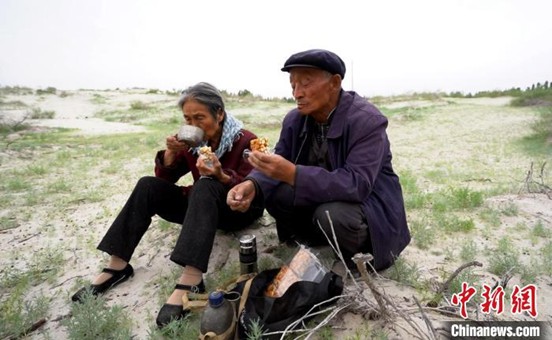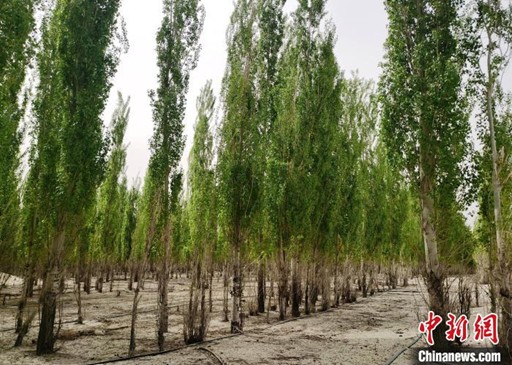By Shi Yujiang and Yang Mengqing
(ECNS) – Viewed from above, a vast belt of poplar trees stretches 34 kilometers along the edge of the endless desert, resembling a “Green Great Wall” that guards Halmodun Village in Hejing County, Xinjiang Uyghur Autonomous Region, on the northwestern edge of the Taklimakan Desert.
This green belt, standing firm against the encroaching desert, is the lifelong work of villager Fu Zhizhou, who spent 41 years planting 800,000 trees.
Fu was honored with the “Green Great Wall Medal,” marking the 40th anniversary of China’s Three-North Shelterbelt Program, and is revered as the “Modern Yu Gong” — the Foolish Old Man Who Moved Mountains—who greened the desert.
“From reclaiming barren land to digging irrigation canals, from battling sandstorms to building an economy rooted in ecology, my father devoted his life to Xinjiang,” said Fu Guoxi, Fu Zhizhou’s second son, standing in front of the first grove his father planted.
“This year marks the 70th anniversary of the founding of Xinjiang,” he added. “As a farmer, this forest was my father’s most heartfelt gift.”
Fighting against the wind: Planting trees in the desert
In 1965, at the age of 22, Fu Zhizhou left Henan Province to support Xinjiang’s development efforts. What greeted him were endless sandstorms and a few scattered mud huts. Years of harsh winds made it nearly impossible to grow crops.
In 1983, a violent sandstorm buried all 47 mu (about 3.13 hectares) of farmland Fu had painstakingly cultivated. Overnight, the sprouting corn and wheat were completely engulfed.
“‘No living man should be defeated by sand!’ my father said, gripping his kantuman with resolve,” Fu Guoxi recalled.
He began planting trees on a dune about 200 meters from his field. The dune, towering more than ten meters high, was no easy terrain. With just a donkey cart, a hoe, and the company of his wife, Chen Ailan, Fu dug holes and planted saplings.
Later, when the donkey could no longer pull the cart through the sand, they switched to oxen.
“My earliest memories are of my parents kneeling under the blistering sun to plant trees, their skin darkened by years of exposure,” Fu Guoxi said.
At that time, sand dunes stretched eight kilometers across Halmodun Village, and vegetation coverage in the Shahezi area was less than 3%.
Fu Zhizhou’s third son, second son, second daughter, and eldest daughter (from left to right) plant trees on the northwestern edge of the Taklimakan Desert. (Photo by Shi Yujiang)
Villagers could only shake their heads and sigh: “Planting trees in the desert is a waste of effort!” and “You might as well throw money into the dunes—you won’t even hear it land.”
Undeterred, Fu Zhizhou and his wife began by planting collected branches into the sand, bowing low with every step, watering each seedling with a single ladleful of water, waging a relentless battle against the sandstorms.
“My father even rallied the whole family,” Fu Guoxi recalled. “Whenever sandstorms struck, while other children ran indoors, we braved the winds, digging pits and supporting young trees.”
United efforts: Carving forests in the desert
“Finally, a splash of green emerged from the desert,” Fu Guoxi said.
After more than a decade, over 100 mu (around 6.7 hectares) of poplars had stubbornly grown into a forest — strengthening Fu’s belief that the desert could indeed be conquered by trees.
Realizing the battle couldn’t be won alone, Fu said, “It’s not enough to plant trees on just our own land—everyone must join in.”
Around that time, the national Three-North Shelterbelt Program launched preferential policies.
“In 2003, my father took out loans to buy bulldozers and tractors and led our entire family to clear land and plant trees,” recalled his third son, Fu Wenping. “We were rarely at home. Meals were simple—just steamed buns, pickled vegetables, and a jug of water. My parents worked all day long in the sand.”

Fu Zhizhou and his wife have their lunch in the desert. (File photo)
Following Fu Zhizhou’s example, Fu Wenping invested business earnings in farm machinery; his second sister-in-law, He Yuyan, gave up her urban job to help with tree planting; the whole family pitched in to support the fight against desertification.
Under the leadership of the Fu family, over 300 households eventually joined the cause. The roar of machinery echoed across the sand.
“My father declared before the villagers, ‘In this lifetime, I will plant one million trees!'” said Fu Wenping.
“Fu Zhizhou pioneered a unique model of desert control: advancing from the front while sealing from the rear, dividing the land into sections, and tackling the easier areas first,” said He Qipeng, director of the Halmodun Village Committee.
Under his leadership, villagers planted a forest stretching 34 kilometers, covering nearly 3,000 mu (about 200 hectares) with over 800,000 trees.
In 41 years, vegetation coverage in Hejing County’s Shahezi region soared from 3% to 70%, while villagers’ incomes multiplied several times.
Passing the Torch, Sustaining the Green Legacy
Years of battling wind and sand took a heavy toll on Fu Zhizhou and his wife.Chen Ailan passed away in 2020 from pneumoconiosis, while Fu suffered from corneal ulcers, impaired lung function, and severe joint deformities in his fingers.In 2024, Fu Zhizhou passed away from illness.
His son, Fu Guoxi, vowed to carry on his father’s dream: “There are still 200,000 trees to go before we reach his one-million goal.”
Fu Guoxi picked up his father’s kantuman (a traditional hoe), but now levels the land with bulldozers and irrigates the saplings using modern spraying systems.
“This spring, we planted 15,000 new poplars, and the survival rate has reached 95%,” he said.

Forest planted by Fu Zhizhou. (Photo by Yang Mengqing)
Fu Guoxi told reporters that villagers now understand, “Planting trees is like depositing money into a ‘green bank.’”
“What Fu Zhizhou left us is not just a forest,” said He Qipeng, “but a spiritual monument to perseverance and devotion rooted deep in the frontier.”
As the sun sets, the 34-kilometer greenbelt is bathed in golden light. Though Fu Zhizhou now rests in peace, a new generation of “Modern Yu Gongs” continues to write an even grander chapter of green transformation.
![]()
![]()
www.ecns.cn (Article Sourced Website)
#Man #builds #Green #Great #Wall #Taklimakan #Desert #years
